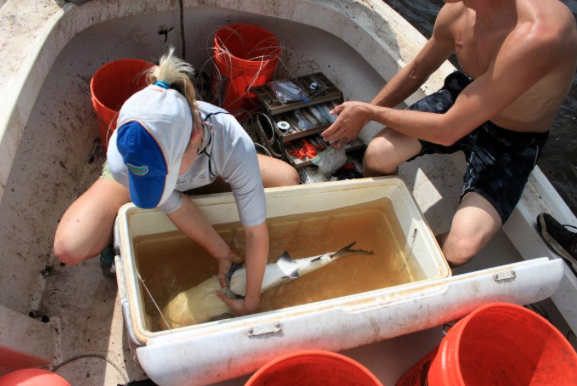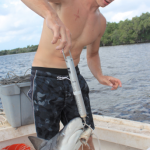Barbara Corbellini Duarte / Assistant news director
Christina Valdes / Contributing writer
Graduate students from the University are pioneering the study of alligators and bull sharks in the Everglades, providing baseline data for the effects the Everglades Restoration Project will have on these predators.
The goal of the research, which takes place in the Shark River Estuary located along the west coast of the Everglades National Park, is to understand the roles of the predators in the ecosystem. Adam Rosenblatt and Philip Matich, doctoral students in the biology department, observe the way alligators and sharks behave in different locations throughout different times of the year, as well as how changes in water quality and variations in weather affect the animals.
“Our research investigating top predators indirectly shows that these are not man-eating, blood thirsty animals to be feared, but rather important components of coastal ecosystems that help regulate the population sizes of smaller species and help maintain the energy and nutrient balance of these ecosystems,” said Matich, who is researching bull sharks.
The research is part of the Comprehensive Everglades Restoration Project, described as the largest environmental restoration effort in history.
The restoration project intends to provide a framework to restore, protect and preserve the water resources of central and southern Florida, including the Everglades.
The Everglades is a natural filtration system that keeps the waters in the South Florida aquifers clean. Aquifers are the underground source of fresh and drinkable water for the community in Miami.
The plan, covering 16 counties over an 18,000-square-mile area, was approved in the Water Resources Development Act of 2000. It consists of more than 60 civil work projects that will be designed and implemented in a period of 30 years. In the October 2007 estimate, the latest available, it was stated that the projects will cost $9.5 billion.
“The Everglades is a very complex ecosystem. There are a lot of elements. There is rainfall. There is heat. There are hurricanes. There’s thousands of different species of plants and animals all interacting with each other,” said Rosenblatt, who is researching American alligators.
According to Rosenblatt, this interaction is crucial to keep the Everglades healthy and to maintain the function of the natural filtration system.
“Predators help regulate the population sizes of other animals to prevent them from overpopulating ecosystems and altering the balance of species within ecosystems,” said Matich.
The research was initiated in 2007 when Rosenblatt began his study of American alligators. Matich began the research on bull sharks in 2008.
To study these predators, Rosenblatt and Matich have tagged more than 100 alligators and bull sharks. At the bottom of the Shark River Estuary lie two monitors: one records the presence of tagged animals; the other measures salinity, temperature and dissolved oxygen in water.
The scientists have observed that the animals often behave differently from one another.
“We’ve been finding more and more that animals have personalities similar to how people have personalities,” Rosenblatt said.
To understand the differences of behavior, Rosenblatt and Matich take blood, muscle and skin samples from the animals. The scientists use the samples to analyze where the predators have been feeding and what they’ve been eating using a technique called stable isotope analysis.
Besides studying alligators, Rosenblatt also examines blue crabs, which are important prey for this predator.
The scientists believe that the predators often have a bad reputation in society.
“In general, many people view some top predators, like sharks, as threats to humans because we coexist in the same habitat (coastal areas), but view other predators, like lions, in a positive light because of our geographical distance from these animals,” said Matich.
Rosenblatt explains that a shark or an alligator attack usually has a great repercussion. People remember these animals as dangerous and don’t realize how atypical these attacks are.
“How many times have we killed them compared to the times they have hurt us?” Rosenblatt asked.
Robin Sarabia, a graduate biology student researching bottlenose dolphins in the Everglades,
said that if the predators and the environment are not preserved and protected, it will cause a domino effect, damaging other species and potentially harming humans. She said that restoring and preserving the national park is essential to maintain the water quality of South Florida aquifers for the future.
“If we are going to want to continue living here and strike a balance with our environment, it’s important to have this restoration effort in order to understand what we are dealing with and why,” Sarabia said. “It’s all connected.”










Be the first to comment on "Into the Everglades – Grad students study the behavior of predators"